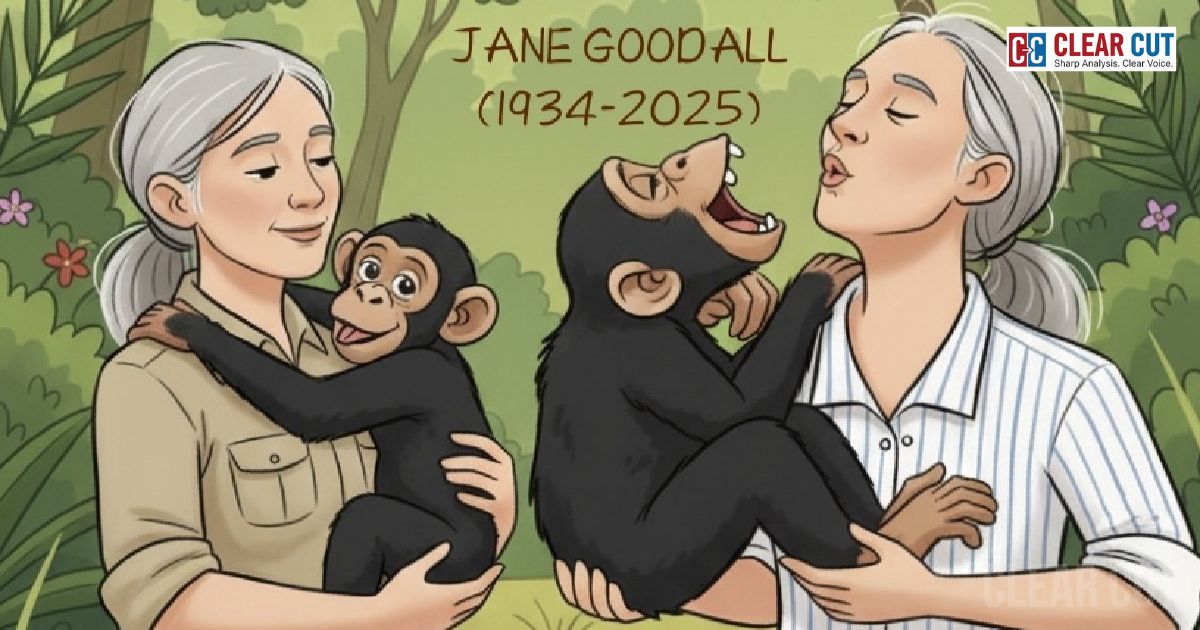Photo Credit: Antara Mrinal
Clear Cut Livelihood Desk
New Delhi, UPDATED: Oct 04, 2025 04:27 IST
Written By: Antara Mrinal
One 1St October, 2025, we lost a beloved scientist and conservationist Valerie Jane Morris-Goodall. Jane was born on April 3, 1934, in London, and was interested in animals and the wildlife from a very young age. That childhood inquisitiveness would become the outgrowth of a career that overturned scientific assumptions. When she first went to Africa she was not a formally educated university degree holder; she relied solely upon patience, observation, and an unconventional empathy towards the animals – attributes that allowed her to observe detail that others had not. In 1960, during her early years studying at Gombe Stream National Park in Tanzania, she changed the scope of field biology by demonstrating how close the behavioral world of chimpanzees are to our own.
Gombe and the Discovery That Changed Everything
In November 1960 she observed a chimpanzee construct a tool – a twig stripped of leaves that it used to “fish” termites from a mound and then reused it. At the time, making tools was an assumption of only humans. Goodall’s finding forced scientist to reconsider definitions of culture, intelligence, and the boundary between human and animal. Over the next decades, she also documented complex behavioral patterns like hunting, politics, grieving, long-term family bonds that indicated chimpanzees were capable of being individuals in complex social routines, as opposed to being simple instinct driven animals. These foundational discoveries are considered landmark in primatology study, and the philosophy of human distinction.
The Jane Goodall Institute
Science was merely the initial chapter of a long journey. In 1977, Goodall established the Jane Goodall Institute (JGI) to protect chimpanzees and their environment, foster community-based conservation on the African continent, and ultimately, translate lessons learned in the field to benefit practical conservation policy. JGI’s work has involved sanctuary management, anti-poaching initiatives, landscape restoration, and community health programs that connect human well-being to wildlife conservation; it is impossible to extract the human factor from JGI’s work. The JGI approach of combining rigorous science with community engagement and education led to a transition in the conservation movement from fortress style protection to stewardship, driven by local communities.
Roots & Shoots
Goodall, knowing well that lasting change relies on engaging the young, created the Roots & Shoots program in 1991 to empower children and youth to create and lead their own local projects that help people, animals, and the environment. What started with a handful of groups has burgeoned into an international program; depending on the source it operates in roughly 60-100 countries, and engages tens of thousands of young changemakers each year in local and community projects. What makes the Roots & Shoots program so powerful is its multiplier effect of teaching young people about leadership, project design, and integrated thinking as it relates to conservation, and this continues to be one of Goodall’s most important legacies to support conservation culture.
United Nations Messenger of Peace
Goodall’s impact extended beyond science, and into global politics. In April of 2002, she was named a United Nations Messenger of Peace, a position that enabled her to facilitate the UN’s attention to the issues of environmental protection and sustainable development. In this capacity she was able to bridge the relevance of grassroots actions to the UN and unite her experience as a scientist and a storyteller to make environmental issues tangible for the public and decision-makers alike. Her work with the UN exemplified a central theme of her life’s work: conservation is effective only if it is linked to scientific evidence, the dignity of humans, and the will for political action.
Science, Storytelling, and Ethics of Empathy
Throughout her career, Goodall always merged an observant gaze with narrative sensibility. She identified chimpanzees by name rather than number, and she wrote for both scientific and popular audiences; books like In the ‘Shadow of Man’ provided insight into the perspective of the animal minds while a plethora of lectures and documentaries expanded the public’s view. And notably, Goodall argued that empathy and ethical concern are not oppositional to science, but necessary complements. Goodall’s perspective opened a new debate on anthropomorphism, ethics in field research, and the levels of responsibilities to other animals used in labs, for food, and for entertainment.
Legacy: Measurable and Moral
The measurable legacy consists of long-term datasets from Gombe that continue to feed into studies of social networks, disease ecology, and conservation outcomes. The institutional legacy includes the Jane Goodall Institute and the worldwide Roots & Shoots network, both of which translate research into conservation action. The moral legacy, which is perhaps more difficult to quantify, is the change she made possible in how society views non-human animals as beings with personalities, emotions, and social lives deserving of our respect and protection. Goodall’s diverse career has included sanctuary work and reforestations, and developed educational curriculum, doing advocacy work for many years at the United Nations, and maintaining a presence in the lab and field, classroom and diplomacy.
Why Her Work Matters Now?
For people living in an era of rapid biodiversity loss, with an increasing climate crisis, there are practical and philosophical lessons from Goodall’s impressive career. Practically, it demonstrates that long-term field research can enable conservation scientists to generate data that can be critically important to species recovery and the management of larger landscapes. Philosophically, Goodall suggests humility, undertaking conservation work while realizing that the future of humanity is connected to the wellbeing of other species. Goodall continues to affirm that working in communities and with young people continues to be a path for conservation that is likely to last longer than conventional methods of conservationists of the last century. Goodall states that conservationists should conserve areas of habitat, provide and support the livelihoods of people living within those areas, and work with the next generation of conservationists to inspire them so we are all engaged in making the world sustainable.
With inputs from:
- Jane Goodall Institute – Gombe history and Roots & Shoots overview
- Britannica – biographical and career summary.
- Roots & Shoots official site — global chapters and program reach.
- United Nations – appointment and role as Messenger of Peace (April 2002).
- History.com / LifeScience – key dates and context for the 1960 tool-use observation.




